Crematogaster rasoherinae
| Crematogaster rasoherinae | |
|---|---|

| |
| Scientific classification | |
| Kingdom: | Animalia |
| Phylum: | Arthropoda |
| Class: | Insecta |
| Order: | Hymenoptera |
| Family: | Formicidae |
| Subfamily: | Myrmicinae |
| Tribe: | Crematogastrini |
| Genus: | Crematogaster |
| Species: | C. rasoherinae |
| Binomial name | |
| Crematogaster rasoherinae Forel, 1891 | |
| Synonyms | |
| |
In natural habitats this species is predominantly arboreal nesting, both in dead twigs as well as in live plant parts. However, ground nesting in rotten logs or branches does occur occasionally. C. rasoherinae is interesting because of the presence of intermediate workers (i.e., individuals intermediate between workers and queens) of unknown function in the colony. I have found intermediates in all four colonies that I collected of this species, with the highest number hereby being eight individuals in one nest. In all cases a normal, dealate queen also was present in the nest. None of the intermediates observed was winged and it seems likely that they are either entirely wingless or brachypterous. Scanning electron micrographs of the lateral mesosoma show the presence of a rudimentary suture above the mesopleuron where in a normal queen the forewing attaches. (Blaimer 2012)
Identification
Blaimer (2012) - Workers of Crematogaster rasoherinae can be distinguished from all other Malagasy Orthocrema by the presence of small anterolateral denticles on the petiole and the rectangular shape of the same. Queens are distinct from all other species by their rectangular petiole shape. In addition, the absence of propodeal spines distinguishes C. rasoherinae queens from Crematogaster madecassa and Crematogaster razana, whereas very small size (HW 0.80–0.89, WL 1.50–1.63) and large eyes (OI 0.30–0.34) easily separate them from Crematogaster volamena and Crematogaster mpanjono.
Keys including this Species
Distribution
Crematogaster rasoherinae is the most widespread species of the Malagasy Orthocrema, and in fact it is one of the most abundant Crematogaster species in Madagascar and on a number of Indian Ocean islands.
Latitudinal Distribution Pattern
Latitudinal Range: 17.48933° to -25.59444°.
| North Temperate |
North Subtropical |
Tropical | South Subtropical |
South Temperate |
- Source: AntMaps
Distribution based on Regional Taxon Lists
Afrotropical Region: Comoros.
Malagasy Region: Madagascar (type locality), Mayotte, Seychelles.
Distribution based on AntMaps
Distribution based on AntWeb specimens
Check data from AntWeb
Countries Occupied
| Number of countries occupied by this species based on AntWiki Regional Taxon Lists. In general, fewer countries occupied indicates a narrower range, while more countries indicates a more widespread species. |
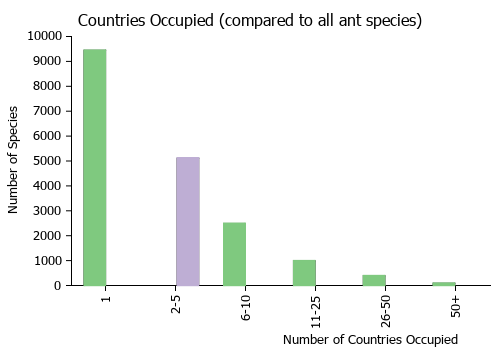
|
Estimated Abundance
| Relative abundance based on number of AntMaps records per species (this species within the purple bar). Fewer records (to the left) indicates a less abundant/encountered species while more records (to the right) indicates more abundant/encountered species. |

|
Habitat
The species is distributed throughout all native forest habitats in Madagascar – rainforest, dry or spiny forest alike – and is also found in disturbed habitats and urban areas. It has been collected at elevations up to 1225m, but appears to be more common at lower elevations.
Biology
Castes
Additional images can be found here
Worker
Images from AntWeb
   
| |
| Worker. Specimen code casent0179558. Photographer Erin Prado, uploaded by California Academy of Sciences. | Owned by CAS, San Francisco, CA, USA. |
   
| |
| Worker. Specimen code casent0134848. Photographer Erin Prado, uploaded by California Academy of Sciences. | Owned by CAS, San Francisco, CA, USA. |
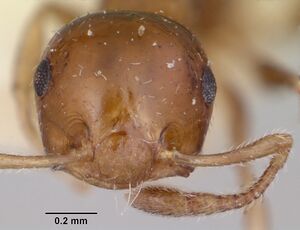 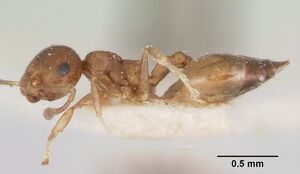  
| |
| Lectotype of Crematogaster rasoherinae brunneola. Worker. Specimen code casent0101836. Photographer April Nobile, uploaded by California Academy of Sciences. | Owned by MHNG, Geneva, Switzerland. |
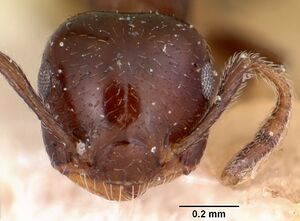   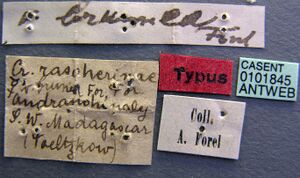
| |
| Syntype of Crematogaster rasoherinae brunneola. Worker. Specimen code casent0101845. Photographer April Nobile, uploaded by California Academy of Sciences. | Owned by MHNG, Geneva, Switzerland. |
Queen
Images from AntWeb
   
| |
| Queen (alate/dealate). Specimen code casent0101785. Photographer April Nobile, uploaded by California Academy of Sciences. | Owned by MHNG, Geneva, Switzerland. |
   
| |
| Queen (alate/dealate). Specimen code casent0136650. Photographer Erin Prado, uploaded by California Academy of Sciences. | Owned by CAS, San Francisco, CA, USA. |
  
| |
| Queen (alate/dealate). Specimen code casent0146298. Photographer Erin Prado, uploaded by California Academy of Sciences. | Owned by CAS, San Francisco, CA, USA. |
Male
Images from AntWeb
   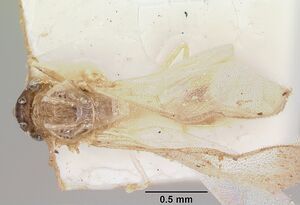 
| |
| Male (alate). Specimen code casent0101617. Photographer April Nobile, uploaded by California Academy of Sciences. | Owned by MHNG, Geneva, Switzerland. |
    
| |
| Male (alate). Specimen code casent0104932. Photographer April Nobile, uploaded by California Academy of Sciences. | Owned by NHMUK, London, UK. |
Nomenclature
The following information is derived from Barry Bolton's Online Catalogue of the Ants of the World.
- rasoherinae. Crematogaster rasoherinae Forel, 1891b: 194 (w.) MADAGASCAR.
- Type-material: neotype worker (by designation of Blaimer, 2012b: 38).
- [Note: original holotype (?) worker: Madagascar: Tamatave (W.H. O’Swald), deposited in Hamburg Museum, destroyed in World War II.]
- Type-locality: neotype Madagascar: Prov. Toamasina, Tamatave, 20 m., 18°09.28’S, 49°24.76’E, 16.ii.2007, BLF16755, urban gardens (B.L. Fisher, et al.).
- Type-depository: CASC (neotype).
- Forel, 1912k: 164 (q.m.).
- Combination in C. (Neocrema): Santschi, 1918d: 182;
- combination in C. (Crematogaster): Wheeler, W.M. 1922a: 1023;
- combination in C. (Mesocrema): Santschi, 1928b: 33;
- combination in C. (Orthocrema): Emery, 1922e: 131; Blaimer, 2012b: 32.
- Status as species: Dalla Torre, 1893: 85; Mayr, 1895: 135 (in key); Forel, 1907g: 79; Forel, 1912k: 164; Emery, 1922e: 131; Wheeler, W.M. 1922a: 1023; Donisthorpe, 1943f: 661; Bolton, 1995b: 161; Dorow, 1996a: 78; Blaimer, 2012b: 38 (redescription).
- Senior synonym of brunneola: Blaimer, 2012b: 38.
- Senior synonym of voeltzkowi: Blaimer, 2012b: 38.
- Distribution: Comoros, Madagascar, Mayotte, Seychelles.
- brunnea. Crematogaster rasoherinae var. brunnea Forel, 1907g: 79 (w.q.) MADAGASCAR.
- Type-material: lectotype worker (by designation of Blaimer, 2012b: 38), 1 paralectotype worker.
- Type-locality: lectotype Madagascar: Andranohinaly (A. Voeltzkow); paralectotype with same data.
- Type-depository: MHNG.
- [Junior primary homonym of Crematogaster brunneus Smith, F. 1857a: 75.]
- Subspecies of rasoherinae: Wheeler, W.M. 1922a: 1023.
- Replacement name: Crematogaster (Orthocrema) rasoherinae var. brunneola Emery, 1922e: 131.
- brunneola. Crematogaster (Orthocrema) rasoherinae var. brunneola Emery, 1922e: 131.
- Replacement name for Crematogaster rasoherinae var. brunnea Forel, 1907g: 79. [Junior primary homonym of Crematogaster brunneus Smith, F. 1857a: 75.]
- Combination in C. (Mesocrema): Santschi, 1928b: 33.
- Subspecies of rasoherinae: Bolton, 1995b: 149.
- Junior synonym of rasoherinae: Blaimer, 2012b: 38.
- voeltzkowi. Crematogaster voeltzkowi Forel, 1907g: 78 (w.) COMOROS.
- Type-material: lectotype worker (by designation of Blaimer, 2012b: 38), paralectotype workers (number not stated).
- Type-locality: lectotype Comoros: Anjouan I. (A. Voeltzkow); paralectotypes with same data.
- Type-depository: MHNG.
- [Misspelled as woelzkowi by Santschi, 1918d: 182.]
- Combination in C. (Neocrema): Santschi, 1918d: 182;
- combination in C. (Crematogaster): Wheeler, W.M. 1922a: 1024;
- combination in C. (Orthocrema): Emery, 1922e: 131.
- Status as species: Emery, 1922e: 131; Wheeler, W.M. 1922a: 1024; Bolton, 1995b: 165.
- Junior synonym of rasoherinae: Blaimer, 2012b: 38.
Unless otherwise noted the text for the remainder of this section is reported from the publication that includes the original description.
Blaimer (2012) - An intriguing characteristic of C. rasoherinae is the morphological variability of this species on the Comoros Islands compared to the remainder of its distribution range. In Madagascar, the Seychelles and Mayotte this species always possesses propodeal spines. On the Comoros Islands in contrast, propodeal spines can be present, reduced or entirely absent. More specifically, all specimens examined from the island of Grand Comore have no, or very reduced propodeal spines, whereas on Anjouan and Moheli propodeal spines are mostly reduced or absent and present only in fewer individuals. This spine-polymorphism was presumably the basis of the description of the here synonymized C. voeltzkowi. Anjouan is the type locality for this species name and the syntype specimens represent the morphological form lacking the propodeal spines. Analysis of DNA sequence data from both the nuclear markers and ancillary mitochondrial data however clearly shows a lack of genetic divergence between the ‘armed’ and ‘unarmed’ forms in C. rasoherinae. The cause and maintenance of this intraspecific polymorphism remains to be investigated.
Description
Worker
Blaimer (2012) - (n=28) Neotype worker: HW 0.64; HL 0.61; EL 0.15; SL 0.45; WL 0.68; SPL 0.07; PTH 0.17; PTL 0.25; PTW 0.18; PPL 0.14; PPW 0.19; LHT 0.44; CI 1.05; OI 0.25; SI 0.74; SPI 0.10; PTHI 0.67; PTWI 0.73; PPI 1.41; LBI 1.53.
Other material. HW 0.51–0.63; HL 0.49–0.62; EL 0.12–0.15; SL 0.38–0.46; WL 0.52–0.65; SPL 0.00–0.10; PTH 0.11–0.16; PTL 0.16–0.24; PTW 0.13–0.19; PPL 0.10–0.14; PPW 0.14–0.21; LHT 0.35–0.44; CI 0.99–1.07; OI 0.21–0.27; SI 0.71–0.82; SPI 0.00–0.17; PTHI 0.60–0.72; PTWI 0.65–0.93; PPI 1.21–1.62; LBI 1.26–1.56.
Very small species (HW 0.51–0.64, WL 0.52–0.68). Masticatory margin of mandibles with 4 teeth; clypeus with several weak vertical carinae; posterior margin of head in full face view usually laterally rounded, sometimes medially slightly depressed; occipital carinae well pronounced; antennal scapes usually just reaching, but not surpassing posterior margin of head; midline of eyes situated well above midline of head in full face view; eyes flush with head, not notably protruding.
Promesonotum laterally subangular, with mesonotum posterolaterally slightly marginate and metanotal groove bordered by weak carinae; in lateral view outline of promesonotum moderately convex; promesonotal suture usually absent; mesonotum with or without a distinct posterior face; metanotal groove with 2–3 median carinae of varying prominence; propodeal spines short (SPI < 0.17) or absent (most Comoros Isl. material), if present straight or upwards curved, in lateral view directed upwards, in dorsal view almost parallel and not diverging; dorsal face of propodeum very short; petiole in dorsal view rectangular, with dorsolateral margins weakly carinate or angular and small antero- and posterolateral denticles; subpetiolar process mostly developed as broad, rounded protuberance, sometimes as small angular dent; postpetiole more or less globular, merely impressed posteriorly, or with faint median impression; subpostpetiolar process often present as small, angular protrusion.
Head sculpture reduced, aciculate; mesosoma with promesonotum dorsally aciculate; meso- and metapleuron aciculate to areolate; propodeum with dorsal face carinulate or reticulate, posterior face shiny; dorsal face of petiole mostly reticulate; helcium dorsally finely areolate; postpetiole dorsally feebly reticulate; lateral and ventral face of petiole and postpetiole areolate or reticulate; face with 2–4 erect flexuous setae, and abundant short, subdecumbent pubescence; pronotum with 0–4 (most often 2) erect, stiff humeral setae, and 0–4 (usually 2) erect, stiff lateral setae on mesonotum, rarely also 2 erect setae present dorsally; mesosoma with scattered decumbent pubescence; petiole with a single stiff, erect seta on each posterolateral tubercle; postpetiole with a pair of erect dorsoposterior setae; abdominal tergites and sternites 4–7 with fairly abundant short erect pilosity (> 20 setae), which is more sparse on tergite 4 and usually present only towards posterior end, and with decumbent pubescence throughout.
Several color variants. Most widespread in Madagascar is a light to dark brown form; less common is a bicolored form with light brown or reddish head and mesosoma and dark gaster. On the Comoros islands, the Seychelles and Mayotte, C. rasoherinae is most often yellow or pale yellow colored, often with the posterior half of the gaster black. The typical brown Madagascar color form seems to be only present on the Seychelles.
Intermediate worker (n=10). HW 0.73–0.84, HL 0.72–0.83, EL 0.18–0.23, SL 0.49–0.56, WL 0.83–1.03, SPL 0.06–0.15, PTH 0.18–0.23, PTL 0.29–0.37, PTW 0.23–0.30, PPL 0.18–0.23, PPW 0.27–0.34 , LHT 0.50–0.57, CI 1.00–1.05, OI 0.24–0.30, SI 0.65–0.75, SPI 0.08–018, PTHI 0.56–0.67, PTWI 0.74–0.88, PPI 0.43–0.53, LBI 1.59–1.84.
Intermediate between workers and queens in size. Head, petiole and postpetiole characters similar to queens; ocelli present, but smaller than in queens; the mesonotum is to various extent raised and fused dorsally over pronotum and has wing attachment sutures; otherwise mesosomal characters more similar to worker characters, especially propodeum, and propodeal spines are present.
Queen
Blaimer (2012) - (n=10). HW 0.80–0.89, HL 0.79–0.88, EL 0.26–0.28, SL 0.51–0.56, MSNW 0.62–0.85, MSNL 0.70–0.90, WL 1.50–1.63, SPL 0.00, PTH 0.20–0.24, PTL 0.35–0.43, PTW 0.26–0.31, PPL 0.21–0.28, PPW 0.31–0.37, LHT 0.62–0.70, CI 0.99–1.02, OI 0.30–0.34, SI 0.62–0.66, MSNI 1.72–1.91, SPI 0.13–0.16, PTHI 0.49–0.63, PTWI 0.62–0.75, PPI 1.30–1.63, LBI 2.19–2.48.
Very small (HW 0.80–0.89, WL 1.50–1.63). With worker characters, except as follows. Masticatory margin of mandibles with 5 teeth. Antennal scapes not surpassing posterior margin of head, reaching only to about level of lateral ocelli; eyes large (OI 0.30–0.34), situated at midline of head in full face view; head shape quadrate (CI 0.99–1.02), posterior margin of head straight.
Mesosoma slender (MSNI 1.72–1.91, WL 1.50–1.63); mesoscutum in dorsal view oval, about half as wide as long; dorsal face of propodeum distinct, about half as long as posterior face; propodeal spines absent; petiole and postpetiole as in worker; anteroventral subpetiolar tooth present, but reduced with respect to worker.
Sculpture smooth and shiny throughout; erect pilosity generally more abundant, but finer than in workers: face with 4–6 longer erect setae and abundant shorter erect to suberect pilosity; mesonotum with abundant short, and scattered longer erect setae; petiole with one pair of long flexuous setae posterior to posterior denticles; postpetiole with flexuous pair of dorsoposterior setae and 2–4 additional long setae; petiole and postpetiole with abundant shorter pilosity throughout. Body color similar to respective workers.
Male
Blaimer (2012) - HW 0.43–0.48, HL 0.34–0.37, EL 0.19–0.22, SL 0.05–0.08, MSNW 0.43–0.53, MSNL 0.38–0.49, WL 0.64–0.80, SPL 0.00, PTH 0.11–0.13, PTL 0.15–0.19 PTW 0.10–0.14, PPL 0.15–0.19, PPW 0.15–0.19, LHT 0.31–0.34, CI 1.19–1.33, OI 0.54–0.59, SI 0.15–0.21, MSNI 1.56–1.80, SPI 0.14–0.17, PTHI 0.64–0.74, PTWI 0.54–0.83, PPI 1.38–1.55, LBI 2.07–2.42.
Very small (HW 0.43–0.48, WL 0.64–0.80). Masticatory margin of mandibles with 2 teeth; eyes very large (OI 0.54–0.59) and protruding, covering most of gena, and reaching anteriorly almost to clypeal margin; antennae 9–10-segmented (separation between 3rd and 4th funicular segment often absent or incomplete), scapes very short (SI 0.15–0.21), 2nd funicular segment globular, last 2 or 3 funicular segments compressed (this may be post mortem); head strongly wider than long (CI 1.19–1.33), mostly due to lateral extent of eyes; ocellar triangle extending to posterior head margin in full face view as a crown; occipital carinae distinct.
Mesosoma fairly slender (MSNI 1.56–1.80, WL 0.64–0.80); mesoscutum in dorsal view slightly wider than long; scutellum with two distinct faces: anterior face short and steeply sloping from mesoscutum, posterior face long and flat; scutellum in dorsal view oval and posteriorly rounded, but dorsoposterior margin carinate; dorsal face of propodeum about as long as posterior face; propodeal spines absent; petiole in dorsal view more or less rectangular, but carinae or denticles absent and all margins rounded, in lateral view petiole anteriorly tapering; anteroventral subpetiolar tooth absent; postpetiole globular, but dorsally somewhat compressed and flat, median impression absent; wings clear.
Sculpture smooth and shiny throughout; face with 2 longer erect setae close to ocelli and sparse short suberect pilosity; mesoscutum with scattered short erect or suberect pilosity; longer erect pilosity present on posterior part of scutellum; petiole with one pair of fine, erect setae; postpetiole with fine dorsoposterior setae. Head medium brown, mesosoma pale yellow, metasoma light brown.
Type Material
Blaimer (2012) - Neotype worker, by present designation: pinned, CASENT0120911, BLF16755, ex dead twig above ground; original locality label: Prov. Toamasina, Tamatave, 20m, 18°09.28'S, 49°24.76'E, 16.ii.2007, urban gardens, Fisher et al. BLF16755; deposited at California Academy of Sciences.
Syntypes not available for examination; these specimens were housed in the collection of the Naturhistorisches Museum in Hamburg and were destroyed during World War II. Confirmation for this has been obtained via e-mail communication with the Naturhistorisches Museum Hamburg (F. Wieland, 19.vii.2011). I designate a neotype in this study to unequivocally ascertain the identity of the species C. rasoherinae, hereby selecting a worker specimen from or close to the original type locality in Madagascar, Tamatave [Toamasina, town]. In a large and taxonomically difficult genus such as Crematogaster type material is indispensable to clarify species identities. Although no closely resembling species is currently known, it is likely that a morphologically similar species could be discovered in the future, either in Madagascar or on the African mainland.
References
- Blaimer, B.B. 2012. Taxonomy and species-groups of the subgenus Crematogaster (Orthocrema) in the Malagasy region (Hymenoptera, Formicidae). ZooKeys, 199, 23-70. doi:10.3897/zookeys.199.2631
- Blaimer, B.B., Fisher, B.L. 2013. Taxonomy of the Crematogaster degeeri-species-assemblage in the Malagasy region (Hymenoptera: Formicidae). European Journal of Taxonomy 51: 1-64 (doi:10.5852/ejt.2013.51).
- Donisthorpe, H. 1943g. A list of the type-species of the genera and subgenera of the Formicidae. [part]. Ann. Mag. Nat. Hist. 11(10): 617-688 (page 661, Combination in C. (Mesocrema))
- Emery, C. 1922c. Hymenoptera. Fam. Formicidae. Subfam. Myrmicinae. [part]. Genera Insectorum 174B: 95-206 (page 131, Combination in C. (Orhocrema))
- Forel, A. 1891c. Les Formicides. [part]. In: Grandidier, A. Histoire physique, naturelle, et politique de Madagascar. Volume XX. Histoire naturelle des Hyménoptères. Deuxième partie (28e fascicule). Paris: Hachette et Cie, v + 237 pp. (page 194, worker described)
- Forel, A. 1912l. The Percy Sladen Trust Expedition to the Indian Ocean in 1905, under the leadership of Mr. J. Stanley Gardiner, M.A. Volume 4. No. XI. Fourmis des Seychelles et des Aldabras, reçues de M. Hugh Scott. Trans. Linn. Soc. Lond. Zool. (2) 15: (page 164, queen, male described)
- Santschi, F. 1918d. Sous-genres et synoymies [sic] de Cremastogaster (Hym. Formic.). Bull. Soc. Entomol. Fr. 1918: 182-185 (page 182, Combination in C. (Neocrema))
- Santschi, F. 1928b. Nouvelles fourmis de Chine et du Turkestan Russe. Bull. Ann. Soc. Entomol. Belg. 68: 31-46 (page 33, Combination in C. (Mesocrema))
- Wheeler, W. M. 1922k. Ants of the American Museum Congo expedition. A contribution to the myrmecology of Africa. IX. A synonymic list of the ants of the Malagasy region. Bull. Am. Mus. Nat. Hist. 4 45: 1005-1055 (page 1023, Combination in C. (Crematogaster))
References based on Global Ant Biodiversity Informatics
- Blaimer B. B. 2012. Taxonomy and species-groups of the subgenus Crematogaster (Orthocrema) in the Malagasy region (Hymenoptera, Formicidae). ZooKeys 199: 23-70
- Blaimer B. B. 2012. Untangling complex morphological variation: taxonomic revision of the subgenus Crematogaster (Oxygyne) in Madagascar, with insight into the evolution and biogeography of this enigmatic ant clade (Hymenoptera: Formicidae). Systematic Entomology 37: 240-260
- Blaimer, B.. "Taxonomy and species-groups of the subgenus Crematogaster (Orthocrema) in the Malagasy region (Hymenoptera, Formicidae)." ZooKeys 199 (2012): 23-70.
- Dorow, Wolfgang H. O. 1995. Review and Bibliography of the ants of the Seychelles (Hymenoptera: Formicidae). J. Afr. Zool. 110:73-96
- Dorow, Wolfgang H.O. 1996. Review and bibliography of the ants of the Seychelles. Journal of African Zoology 110(2): 73-95.
- Fisher B. L. 1997. Biogeography and ecology of the ant fauna of Madagascar (Hymenoptera: Formicidae). Journal of Natural History 31: 269-302.
- Fisher B. L. 2003. Formicidae, ants. Pp. 811-819 in: Goodman, S. M.; Benstead, J. P. (eds.) 2003. The natural history of Madagascar. Chicago: University of Chicago Press, xxi + 1709 pp.
- Forel A. 1907. Ameisen von Madagaskar, den Comoren und Ostafrika. Wissenschaftliche Ergebnisse. Reise in Ostafrika 2: 75-92.
- Forel A. 1912. The Percy Sladen Trust Expedition to the Indian Ocean in 1905, under the leadership of Mr. J. Stanley Gardiner, M.A. Volume 4. No. XI. Fourmis des Seychelles et des Aldabras, reçues de M. Hugh Scott. Trans. Linn. Soc. Lond. Zool. (2) 15: 159-167.
- Goodman S., Y. Anbdou, Y. Andriamiarantsoa, B. L. Fisher, O. Griffiths, B. Keitt, J. J. Rafanomezantsoa, E. Rajoelison, J. C. Rakotonirina, L. Ranaivoarisoa et al. 2017. Results of a biological inventory of the Nosy Ankao island group, Parc National de Loky-Manambato, northeastern Madagascar. Malagasy Nature, Association Vahatra, 2017, 11, <http://www.vahatra.mg/volume11fr.html>
- Ravelomanana A., and B. L. Fisher. 2013. Diversity of ants in burned and unburned grassland , and dry deciduous forest in the Beanka Reserve, Melaky Region, western Madagascar. Malagasy Nature 7: 171-183.
- Soulié J., and L. D. Dicko. 1965. La répartition des genres de fourmis de la tribu des "Cremastogastrini" dans la faune éthiopienne et malgache. Hymenoptera - Formicoidea - Myrmicidae. Ann. Univ. Abidjan Sér. Sci. 1: 85-106.
- Wheeler W. M. 1922. Ants of the American Museum Congo expedition. A contribution to the myrmecology of Africa. IX. A synonymic list of the ants of the Malagasy region. Bulletin of the American Museum of Natural History 45: 1005-1055

